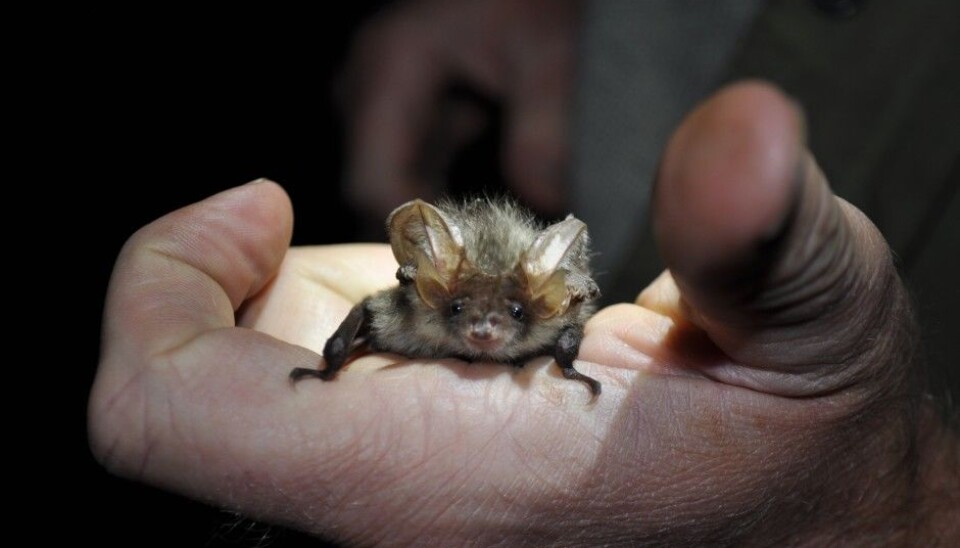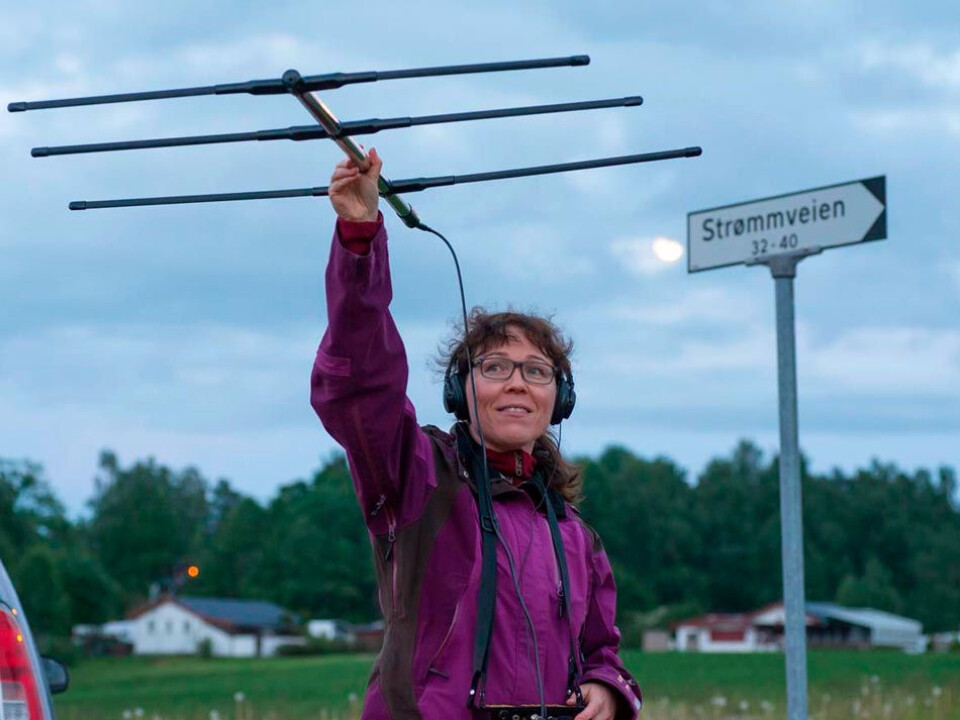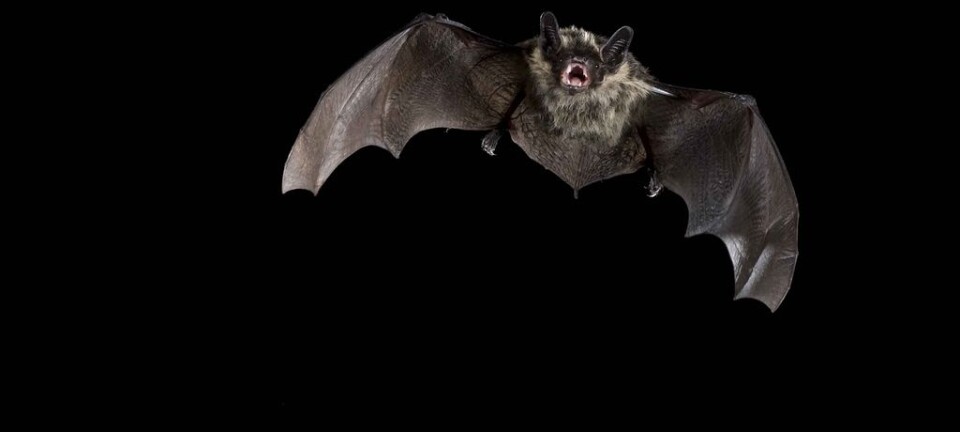An article from Norwegian University of Life Sciences (NMBU)

Technology revealing the secret life of bats
Using digital technology and radio transmitters, researchers are going to find out where Norwegian bats live their lives.
They are small and they can fly, and some people shudder at the very thought of them - bats. But where do they live?
We know surprisingly little about bats. A new project aims to rectify this by attaching radio transmitters to a number of bats. The information from these transmitters will then be collated with data from laser scans and geographic information systems (GIS).
Together, these technologies will enable us to learn more about the everyday lives of bats.
Needle in a hay stack
However, this is easier said than done. After all, how do you map the movements of a tiny animal that can fly huge distances, likes to hide, and is most active at the darkest time of day?

"It's a bit like looking for the proverbial needle in the hay stack," says Katrine Eldegard of the Norwegian University of Life Sciences (NMBU).
She is heading a new, major bat project – SCANDBAT. In this project, NMBU researchers are collaborating with the Norwegian Zoological Association's bat group and the Norwegian Institute for Nature Research (NINA) in order to fill some of the many knowledge gaps about Norway's bats.
Radio transmitters, lasers and GIS
The technological solution to the problem is to attach small radio transmitters to bats. Data from these transmitters revealing where they fly can be linked to detailed landscape information produced using airborne laser scanners.
"Using this information, we will be able to find out which areas the bats prefer and when," says Eldegard.
Finding their favourite places

The researchers expect to find that bats do not use the landscape in which they move randomly, but that they fly with purpose and aim. They probably have preferred areas for hunting, and other areas where they look for a partner. They also expect to find that the bats have favourite trees and buildings to sleep in during the day, and that they alternate between areas and regions, depending on the season.
"Today's laser technology can provide amazingly detailed information about landscapes, right down to the individual tree," says Eldegard.
The researchers will thus be able to deduce many exciting details about what kind of trees and landscapes bats prefer.
Using the landscape
In addition to information about which areas the bats move between, the researchers also want to know how they get there.
"One theory is that certain elements in the landscape function as a kind of 'highway'," she says.
For example, a strip of woodland in an urban area might be essential for their ability to move from one area to another.
Bats over Oslo's rooftops
If the bats remain in the area where they are released, they can be tracked using hand-held Yagi antennas. The first sample of bats has already been tagged and released from rooftops in the Oslo area.
"The radio transmitters are small and have quite a limited range. If the bats fly a long distance, we will use planes to find them," says Eldegard.
The researchers' aircraft are now trawling the whole of central eastern Norway in search of radio signals from bats that have ventured far.
A sign of good luck or vampires?
Steeped in myth, these winged creatures have captivated human imagination since the dawn of time.
In Mexican mythology, they are seen as symbols of death and the underworld, while in China they are seen as harbingers of good fortune and longevity. For the Mayans, bats symbolised change and rebirth. In the West, the Dracula myth has dominated twentieth-century culture, giving bats an undeserved negative image.
"Bats are social animals that form strong bonds with other members of their species and that can live for more than 20 years. There is much more to their lives than you might think," says Eldegard.
Big knowledge gaps
Despite the fact that bats have been the subject of human imagination for millennia, we still know surprisingly little about them. Especially here in Norway.
"Researchers often talk about a lack of knowledge. In the case of bats, this is no understatement," Eldegard says, adding:
"For several decades, the Norwegian Zoological Association's bat group has done an important job mapping bats and developing methods. In addition, there has been some research on bats using radiotelemetry in western Norway and in Troms in the north, but otherwise there has been very little research on bats in Norway."
There are many unanswered questions: Where do Norwegian bats hunt? Where do they spend the winter? Where do they go to look for a mate? Which areas are important for food and sleep? Where do they rest during the daytime, and where do they feed their young? What landscapes do they prefer? The list goes on and on.
Endangered, but we do not know why
All of these knowledge gaps mean that, in the worst case, we might destroy essential bat habitats without even realising the consequences. Several of the Norwegian species are endangered, but researchers do not know why.
"The most probable explanation is that there is a combination of causes," says Eldegard.
She lists a number of factors that affect bats, including disturbance of colonies, pollution, habitat loss, and changes in landscapes and land use.
In brief, we currently lack the knowledge we need to be able to make good decisions and implement effective measures. This is where Eldegard's project comes in.
Vulnerable habitats
One challenge facing the modern bat is access to suitable nursing colonies. There is a shortage of hollow trees. If colonies are disturbed when they are particularly vulnerable, such as when the young have just been born or are nursing, the consequences can be catastrophic.
"We know from other countries that nursery sites are of vital importance to bat populations. But of equal, if not greater, importance is access to good hunting habitats with plenty of insects," Eldegard adds.
Where do they go in winter?
In winter, the bats in Norway hibernate. All their bodily functions, including temperature and breathing, are reduced to a minimum. Hibernating bats may breathe less than once an hour, and their pulse can fall to 10 beats per minute.
One advantage of this period, from a research point of view, is that the animals stay in one place. And the research team makes good use of this. Volunteers and researchers map well-known winter roosts and count bats during the winter. However, in these winter counts we register only a tiny fraction of the number of bats registered during the summer.
"In the winter counts, we find probably less than 1% of the total population. We do not know where the remaining 99% of the bats go to hibernate. Hibernation makes them vulnerable. If a wintering site disappears, many – perhaps hundreds or even thousands of individuals – may be affected. Knowledge about this is therefore very important to ensure good bat management," says Eldegard.
The unknow
This project is a very exciting opportunity for researchers who enjoy delving into the unknown.
"This is a pilot project in many areas. We are going to do many things that have never been done before in Norway," says Eldegard.
However, she is aware that there will probably be challenges along the way:
"This project is at the very limit of what can be done with the current technology. At the moment there are no GPS transmitters small enough to be used on the species of bat we are studying in this project. So we are having to use traditional VHF transmitters. The transmitters are very small and have a limited range. This makes the job of locating the transmitters more challenging.
Nocturnal mosquito hunters
Now that you know a bit more about bats, perhaps you no longer find them quite as scary as before?
"If you notice bats are swooping and diving around your head, remember that they are actually doing you a favour – they are probably eating mosquitoes. They are excellent hunters, so just let them get on with it, and you will end up with fewer mosquito bites," Eldegard says.
-------------------------------
Read the Norwegian version of this article at forskning.no































